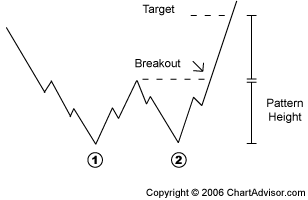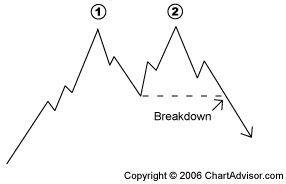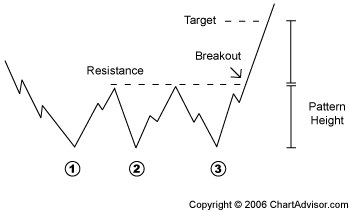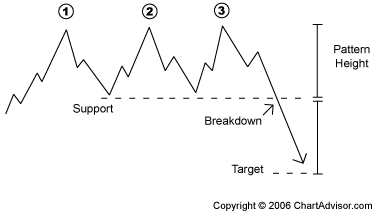Assume the market advances to point C. If the trading range between points A and B has been relatively narrow and the time period of the lateral movement relatively long, the accumulated buy stops above the market could be quite numerous. Also, as the market breaks above point B, brokers contact their clients with the news, and this results in a stream of market orders. As this flurry of buyers becomes satisfied and profit-taking from previous long positions causes the market to dip from the high point of C to point D, another distinct attitude begins working in the market.
Part of the first group that went long between points A and B did not buy additional contracts as the market rallied to point C. Now they may be willing to add to their position "on a dip." Consequently, buy orders trickle in from these traders as the market drifts down.
The second group of traders with short positions established in the original trading range have now seen prices advance to point C, then decline to move back closer to the price at which they originally sold. If they did not cover their short positions on a buy stop above point B, they may be more than willing to "cover on any further dip" to minimize the loss.
Those not yet in the market will place price orders just below the market with the idea of "getting in on a dip."
The net effect of the rally from A to C is a psychological change in all three groups. The result is a different tone to the market, where some support could be expected from all three groups on dips. (Support on a chart is denned as the place where the buying of a futures contract is sufficient demand to halt a decline in prices.) As this support is strengthened by an increase in market orders and a raising of buy orders, the market once again advances toward point C. Then, as the market gathers momentum and rallies above point C toward point E, the psychology again changes subtly.
The first group of long traders may now have enough profit to pyramid additional contracts with their profits. In any case, as the market advances, their enthusiasm grows and they set their sights on higher price objectives. Psychologically, they have the market advantage.
The original group who sold short between A and B and who have not yet covered are all carrying increasing losses. Their general attitude is negative because they are losing money and confidence. Their hopes fade as their losses mount. Some of this group begin liquidating their short positions either with stops or market orders. Some reverse their position and go long.
The group which has still not entered the market — either because their orders to buy the market were never reached or because they had hesitated to see whether the market was actually moving higher — begins to "buy at the market."
Remember that even if a number of traders have not entered the market because of hesitation, their attitude is still bullish. And perhaps they are even kicking themselves for not getting in earlier. As for those who sold out previously-established long positions at a profit only to see the market move still higher, their attitude still favors the long side. They may also be among those who are looking to buy on any further dip.
So, with each dip the market should find the support of 1) traders with long positions who are adding to their positions; 2) traders who are short the market and want to buy back their shorts "if the market will only back down some"; and 3) new traders without a position in the market who want to get aboard what they consider a full-fledged bull market.
This rationale results in price action that features one prominent high after another and each prominent reactionary low is higher than the previous low. In a broad sense, it should appear as an upward series of waves of successively higher highs and higher lows.
But at some point the psychology again subtly shifts. The first group with long positions and fat profits is no longer willing to add to its positions. In fact they are looking for a place to "take profits." The second group of battered traders with short positions has finally been worn down to a nub of die-hard shorts who absolutely refuse to cover their short positions. They are no longer a supporting element, eagerly waiting to buy the market on dips.
The third group of those who never quite got aboard the up-move become unwilling to buy because they feel the greatest part of the upside move has been missed. They consider the risk on the downside too great when compared to the now-limited upside potential. In fact, they may be looking for a place to "short the market and ride it back down."
When the market demonstrates a noticeable lack of support on a dip that "carries too far to be bullish," this is the first signal of a reversal in psychology. The decline from point I to point J is the classic example of such a dip. This decline signals a new tone to the market. The support on dips becomes resistance on rallies, and a more two-sided market action develops. (Resistance is the opposite of support. Resistance on a chart is the price level where selling pressure is expected to stop advances and possibly turn prices lower.)
The downturn
Now the picture has changed. As the market begins to advance from point J to point K, traders with previously-established long positions take profits by selling out. Most of the hard-nosed traders with short positions have covered their shorts, so they add no significant new buying impetus to the market. In fact, having witnessed the recent long decline, they may be adding to their short positions.
If the rally back toward the contract highs fails to establish new highs, this failure is quickly noticed by professional traders as a signal the bull market has run its course. This is even more true if the rally carries only up to the approximate level of the rally top at point G.
If the open interest also declines during the rally from J to K, it is another sign it was not new buying that caused the rally but short covering.
As profit-taking and new short-selling forces the market to decline from point K, the next critical point is the reactionary low point at J. A major bear signal is flashed if the market penetrates this prominent low (support) following an abortive attempt to establish new contract highs.
In the vernacular of chartists, a head-and-shoulders reversal pattern has been completed. But rather than simply explaining away price patterns with names, it is important to understand how the psychology of the market action at different points causes the market to respond as it does. It also explains why certain points are quite significant.
In a bear market, the attitudes of the traders would be reversed. Each decline would find the bears more confident and prosperous and the bulls more depressed and threadbare. With the psychology diametrically opposite, the pattern completely reverses itself to form a series of lower highs and lower lows.
But at some point, the bears become unwilling to add to their previously-established short positions. Those who were already long the market and had refused to sell higher would eventually be reduced to a hard core of traders who had their jaws set and refused to sell out. Traders not in the market who were perhaps unsuccessfully attempting to short the market at higher levels will begin to find the long side of the market more attractive. The first rally that "carries too high to be bearish" signals another possible trend reversal.
With this basic understanding of market psychology through three phases of a market, a trader is better equipped to appreciate the significance of all technical price patterns. No one expects to establish short positions at the high or long positions at the low, but development of a feel for market psychology is the beginning of the quest for trades that even hindsight could not improve upon.
When you analyze charts, approach them with the idea that they reflect human ideas about prices that are the result and the struggle between supply and demand forces. Your attitude and ability to judge market psychology will determine your success at chart analysis. Unexpected occurrences can change price trends abruptly, and without warning. Also, some of the chart formations may be hard to visualize. You'll sometimes need a good imagination as well.
===> Click
BACK TO CHAT BOX






























